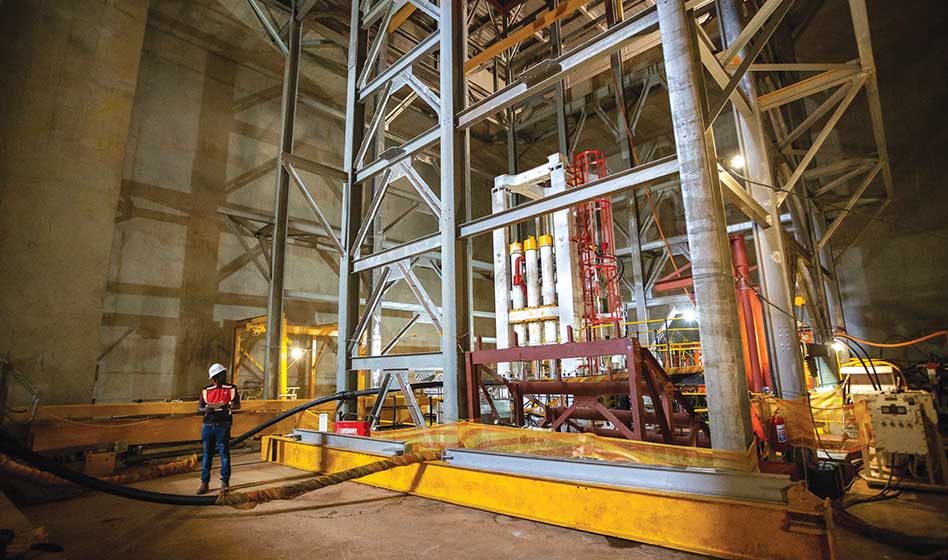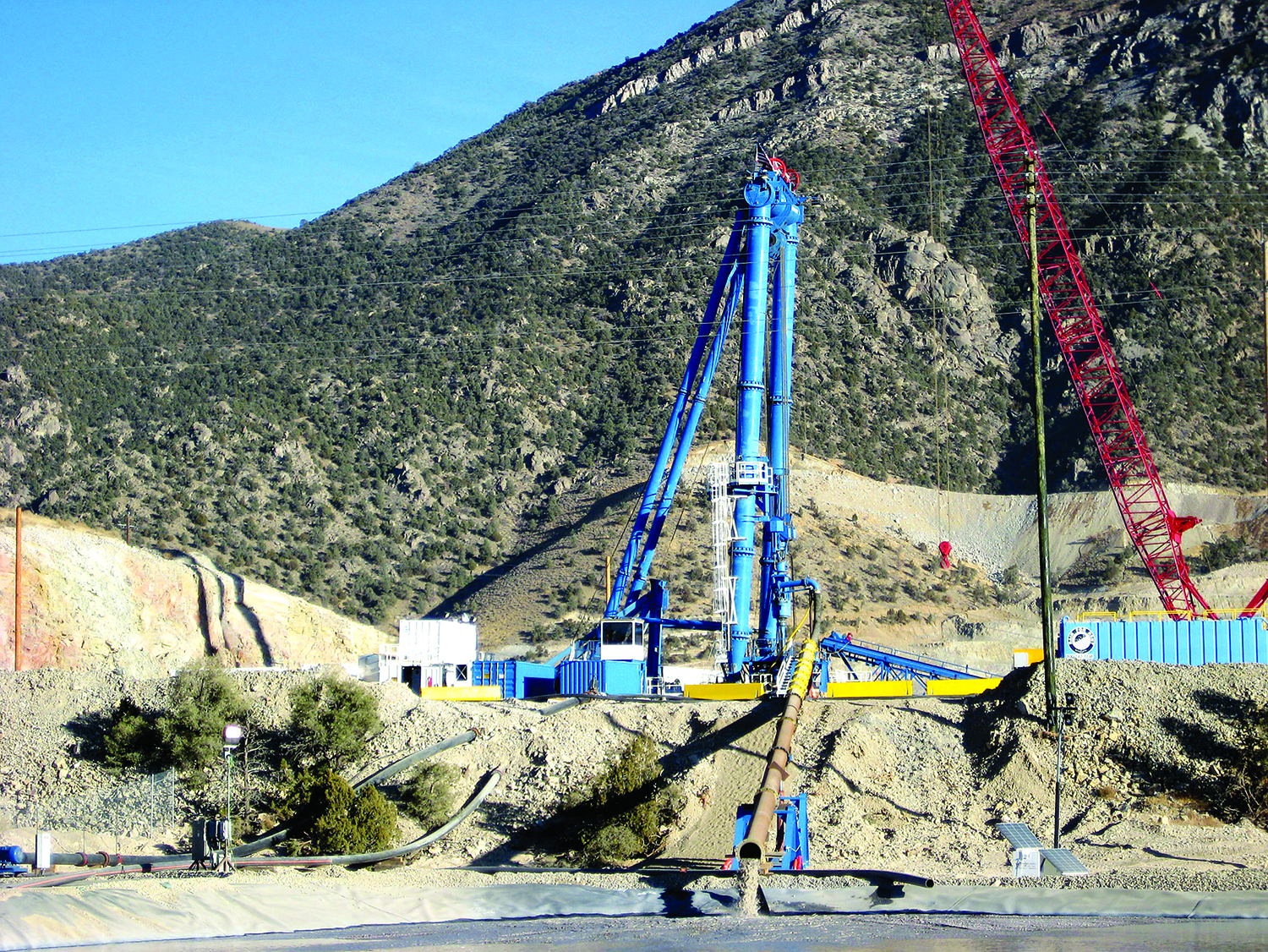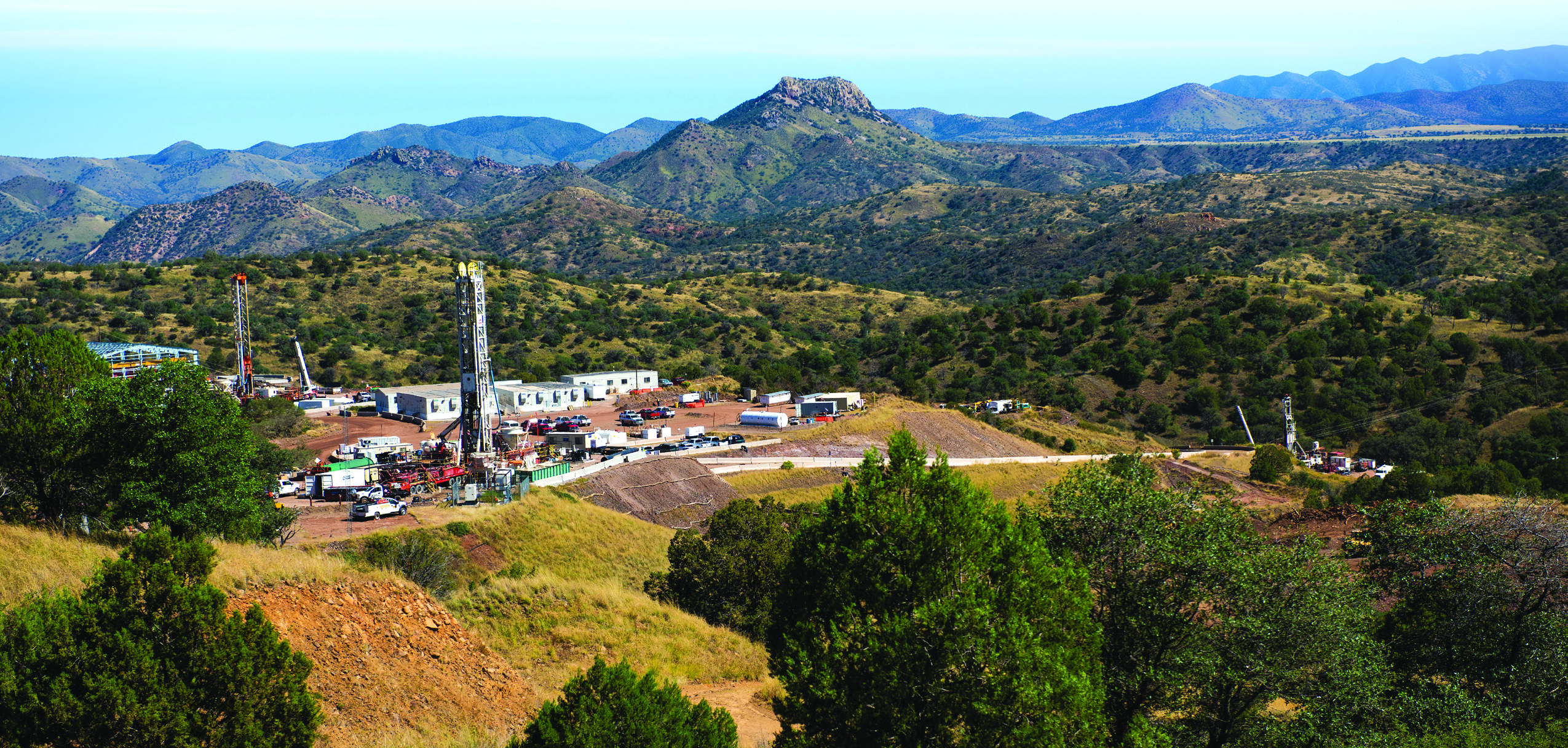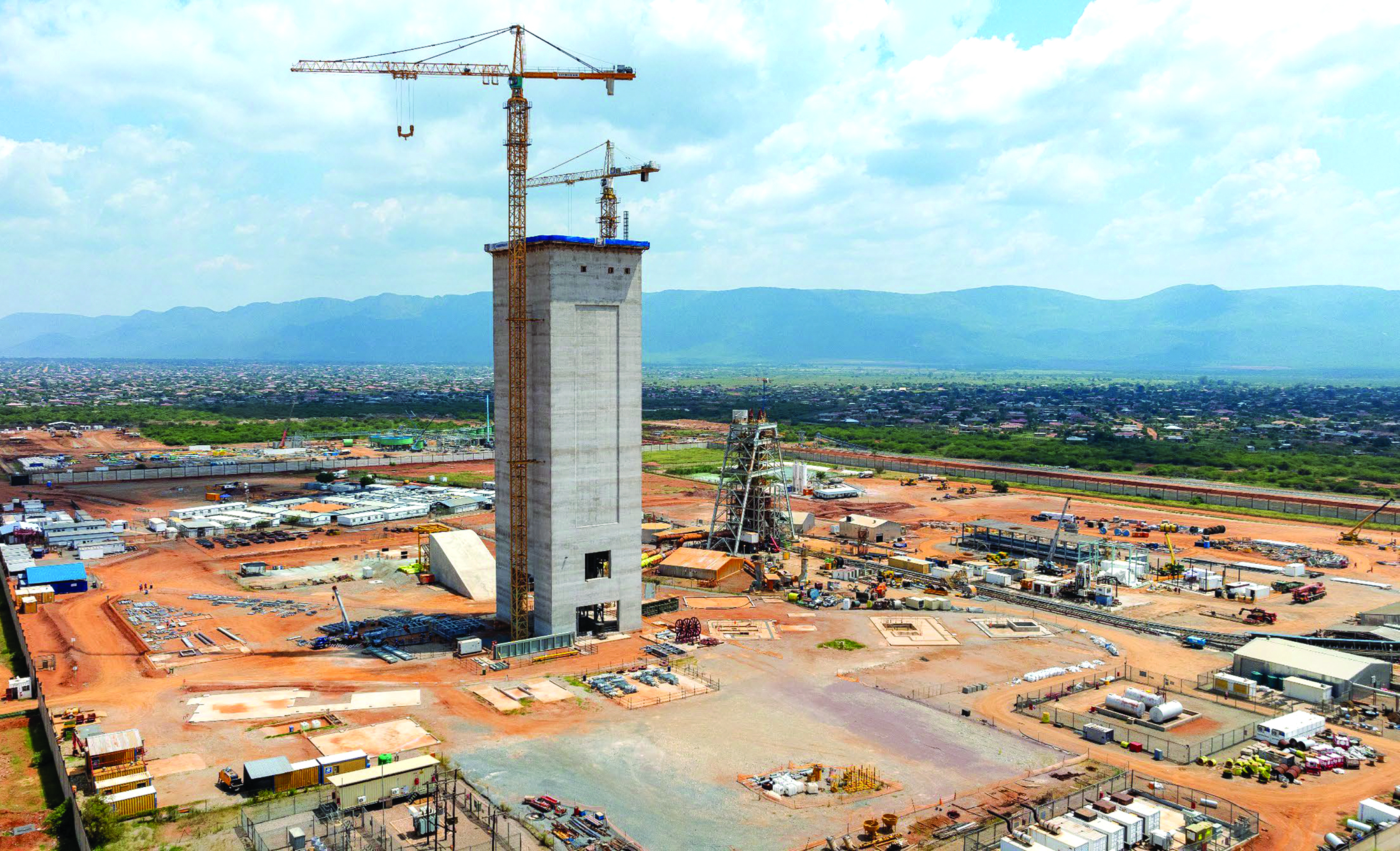
Murray & Roberts Cementation is sinking a 5.1m ventilation shaft at Ivanhoe Mines’ Platreef project to meet horizontal development at 950 metres below surface. (Photo: Murray & Roberts Cementation)
E&MJ explores advances in shaft sinking, raiseboring and hoisting with five industry leaders
By Carly Leonida, European Editor
As near-surface orebodies become depleted and demand for minerals and metals grows, there is only one way that mining operations can realistically go, and that is down. Accessing new deposits or orebody extensions is often contingent upon the development of infrastructure and, for the engineers and contractors who specialize in designing and building vertical developments, as well as the OEMs and technology firms who equip them, business is booming.
To explore key trends as well as projects underway globally, E&MJ invited a selection of experts to share their insights.
“The most crucial trend in both design and execution of these projects is to make the work as safe as possible and ensure zero harm,” Eric Kohtakangas, senior executive vice president of Cementation Canada Inc., told E&MJ. “There is a big focus on making shaft sinking systems safer, and overall, the industry has done a lot of work in the past two decades to mitigate the critical hazards in both shaft sinking and raiseboring.”
Cementation is an underground mine contracting and engineering company providing mine development and production services for clients worldwide. “We design all our own shaft sinking setups,” Kohtakangas said. “We can design permanent headframes, shafts, and hoisting plants along with the required materials handling systems and we can design the required shaft sinking setups. In most shaft sinking projects, the temporary designs are incorporated into the permanent designs to provide the best value to the owner. The benefit Cementation brings is that we offer this entire service under one roof with one point accountability, making it far more efficient to remove several interfaces.”
He added: “For Cementation, some of our biggest technological advances are in the area of shaft obstructions and making sure our sinking systems are equipped with the necessary safeties to ensure we don’t encounter an incident with a moving conveyance, i.e., the shaft bucket, where there could be major loss or serious or even fatal injuries.”
Cementation’s Raisebore Group was recently a top performer in the North Atlantic Division for a Kaizen competition at Vale’s Thompson Mine Expansion project in Manitoba, Canada. The group developed a safety innovation which included a mat interlock system. This automatically stops the drill string from turning when a person steps onto the mat in proximity to the rotating drill string.
“We are extremely proud of the work our team performed at the Vale Thompson raisebore,” said Kohtakangas. “Our group also completed 365 days of operations on-site with zero harm, no incidents, or injuries.”
Removing People From Harm’s Way
Today, the preference in shaft sinking is to remove workers from hazardous environments altogether, or at least ensure there is separation between the worker and the shaft bench and walls during every task across the cycle. One approach to this is mechanical cutting, the application of which largely depends on the rock hardness. Another is making all tasks in the shaft sinking cycle automated or remote-controlled.
Kyle Wooton, senior vice president of operations at Frontier-Kemper Constructors Inc. (FKCI), told E&MJ: “Shaft sinking continues to become more automated in general. Reducing the number of labor hours associated with the project is also desirable. The increase in automation not only creates a safer work environment through reduced exposure, but it also aids in overcoming any skilled staffing shortages that a contractor may face.”
FKCI offers turnkey engineering, procurement, construction and management (EPCM) for shaft sinking projects, utilizing raiseboring, blind boring, and conventional methods. This includes permanent hoisting solutions, such as hoists, headframes, vertical belts, skips, and cages through the company’s FK-Lake Shore division.
“We are one of the only contractors to offer a complete in-house shaft and permanent hoisting construction solution,” said Wooton. “FKCI has a project that recently started in Virginia, USA, which is a 28 feet (8.5 meter) diameter shaft with a depth over 2,000 ft (609 m). The shaft will be mined using conventional drill and blast techniques, including a four-boom hydraulic shaft jumbo that was designed and built by FKCI’s equipment department.”
The team at Redpath Mining has also noticed the trend towards automation. Redpath offers turnkey shaft sinking services, starting from the early feasibility stages to support client decision making, following through detailed engineering and procurement, site construction and shaft sinking, and finally permanent system commissioning, training and handover.
Kevin Melong, vice president, shafts and technical services, Redpath Canada Ltd., explained: “There is a desire to remove workers from the shaft bottom, as well as avoid traditionally manually tasks, and this is placing a higher importance on mechanization and automation. Winder controls and the application of wireless technologies that allow a high level of control and monitoring of the sinking system are some other important advances.”
Tyler Foy, manager, engineering and technical services at Redpath Canada Ltd., added: “The most obvious benefit to the inclusion of newer technologies in the last decade is the immediate impact on safety systems. Sensors, switches, and new communications have allowed additional checks and balances during operation, providing additional layers of safety. Furthermore, as technology advances and previous manual or hazard-prone tasks continue to be mechanized, or automated, the level of worker safety only continues to increase.”
Deeper, More Challenging Developments
Over the past 10-20 years, shaft sinking and drilling equipment has become substantially larger. While deep shafts and complex lithologies have been handled for many years, as deeper vertical developments are created, there’s often an increase in risks associated with ground conditions. Earth pressures are greater which can result in rock bursts, bottom heaves, or carry increased risk of water inflows and hazardous gases. This can be a major concern, although, as Foy reminded us: “Shaft sinking is somewhat unique in that the traditional approach to shaft excavation is, to a certain extent, scalable and adaptable to accommodate a variety of depths and geologies.”
Today, raiseboring and blind boring machines are also successfully mining shafts that are much deeper and with larger diameters compared to those of the past. Shafts depths that would once have been considered a ‘new record,’ have become the new normal.
Wooton pointed out: “The increase in depth creates much more square footage of exposed ribs, particularly in raiseboring, which can create a ground stability concern depending on the strata. Advances in ground treatment technology, such as ground-freezing, grouting, and concrete have aided in mitigating some of the potential challenges.”
Kohtakangas noted that more difficult ground conditions are a particular challenge at base metal projects where new, deeper deposits are being developed, or brownfield operations extended.
“We have seen challenges with rock stress, water inflows, and high ambient rock temperatures,” he said. “Most recently, Cementation completed an internal shaft in a base metal mine to a depth of about 8,650 ft (2,636 m) below the surface where the ground was so highly stressed that the shaft miners could not work directly on the shaft bench. The Cementation group has sunk many of the deepest shafts globally, including in North America, and we were able to generate ideas to advance the sink without stopping the project.”
He added that in raiseboring, two trends stand out: the ability to bore much larger diameter holes over greater lengths, and also the accuracy with which vertical holes can now be drilled. Cementation’s raise group in North America recently completed two 3,529 ft holes at 10 ft diameter for Vale’s Thompson mine. The pilot hole was the longest drilled in North America and drilled on target. The group uses a rotary vertical drilling system (RVDS) tool to ensure accuracy (deflection) is less than 0.1% on the drilling distance, even in the toughest of conditions.
“We also worked closely with Sandvik to design, engineer, and manufacture a reaming head that could be diminished in diameter from the outside versus manufacturing different diameters of outside wings,” Kohtakangas explained. “This allows for one reamer head versus multiple varying reamer diameters where different hole diameters may be required over the hole length.”

The FKCI team at work on a ventilation shaft at Barrick’s Cortez mine in Nevada, US. (Photo: Frontier-Kemper Constructors, Inc.)
Digital Breakthroughs
Digital technologies have provided some of the greatest advances of recent years when it comes to safety and productivity. For example, FKCI recently lowered multiple pieces of large mining equipment down a deep shaft for a client using an innovative monitoring set up.
“These critical lifts were continually monitored as they were lowered down the shaft using high-resolution digital cameras and lighting,” said Wooton. “The hoist operator was able to monitor the load in real time, and no personnel were required to be in the shaft during the pick.”
Foy added: “Digital solutions inherently provide more visibility and access to information than hard copies. This sharing of information improves quality control and procedural documentation. It also enhances the dissemination of safety-related information.”
Cementation has developed a Performance Management System that continuously drives ideas and actions for improvements at its projects. “We combine several digital systems to drive performance,” said Kohtakangas. “One is a short interval control (SIC) system using a software called GroundHog. The SIC helps maximize face utilization by using real-time data.”
The program allows access to real-time information throughout the shift during a shaft sinking operation. As the sinking or mine development process progresses during the shift, the team can make data-driven decisions on the shaft bench rather than wait for the end-of-shift report. This ensures all stakeholders are aware of the project’s progress in real time, providing visibility with positive outcomes for short-term planning and reconciliation to the original plan.
Kohtakangas said: “There’s no doubt that with the global electrification push combined with a shift towards a greener economy, we feel the market will remain healthy for shaft sinking and large diameter raisebore opportunities. In Canada alone, Cementation has been involved in 18 shafts over the past two decades, and we expect this trend to continue.
“The challenge the industry faces is the time it takes today to develop, approve, and build a new mine from first discovery to production, which has significantly increased over the past 20 years. We will continue to see existing operations going deeper, but then the challenge or risk will shift towards finding a safe and economical way to mine at these increased depths.”
From Alamos and Hermosa to Woodsmith
Redpath Mining is currently sinking the shafts at Alamos Gold’s Island Gold mine in Dubreuilville, Canada, and at South32’s Hermosa project in Arizona, USA. At both jobs, Redpath has provided EPC services, and the company detailed the scope in the Winter ’24 edition of its Advance magazine. At Hermosa, the project includes detailed engineering for two headframes, shafts, permanents hoists and loadout.
“Engineering design to support the sinking of both shafts is also included, comprising hoists and winches, Galloway, dump, collar and buckets, as well as electrical distribution, instrumentation, and control using Redpath’s internal resources,” Redpath stated in the article. “Redpath is also in charge of preparing procurement packages to purchase the permanent and temporary equipment. The project is Redpath’s largest engineering project ever, requiring over 50,000 hours of engineering work and a full-time project controller and scheduler.”
The company explained that Redpath’s teams act as “engineers with a construction mindset.” This means that they incorporate permanent structures and production aspects into the early stages of each project’s life cycle. The result is an expedited and streamlined process with time and cost savings.
“The Hermosa project broke ground last summer [2023], on one of two exploration shafts that will be excavated by Redpath USA to a planned depth of 2,947 ft. The shafts will enable underground access for continued exploration of a world-class deposit containing the US-critical mineral, zinc, as well as lead and silver – minerals needed for supporting electrification and renewable energy,” stated the company.
At Alamos, Redpath’s engineering team has collaborated closely with the headframe designers to accommodate the collar doors, dump doors and winch sheaves into the headframe. Redpath’s engineers also worked with the headframe supplier and erector, planning the installation of the sinking components into the headframe.
The company explained: “In an effort to minimize work at site and reduce elevated work, the Galloway was shipped in two erected components. The Redpath-designed and fabricated components were pre-assembled with lifting points to minimize erection time.”
Melong told E&MJ: “We have also recently completed the material handling shaft at the Woodsmith potash mine in England, UK, while our German group, Redpath Deilmann, is sinking the production and service shafts.”

South32 begins construction activity on an exploration shaft at Hermosa, which will be used to further define one of the world’s largest undeveloped zinc resources. (Photo: South32)
Again, this project featured in Advance: Redpath Deilmann is using shaft boring roadheader (SBR) technology to sink two 4,921 ft-deep mine shafts and a 1,050 ft-deep mineral transport system (MTS) shaft with lateral development.
Redpath said: “The project has challenging boundary conditions. It is located in a national park and the rock becomes much harder near the 2,625 ft depth. Pre-sinking investigations showed that the shaft is anticipated to intersect high pressure ground water. The expectation is that Redpath’s teams can sink through these challenges with high sinking rates.”
Foy told E&MJ: “The outlook seems good for shaft-sinking work in the coming years. Numerous other projects are in various states of feasibility and planning, which should maintain or exceed current working levels.”
Work Continues at Venetia, Platreef and Palabora
In southern Africa, Murray & Roberts Cementation is executing projects at De Beers’ Venetia mine, Ivanhoe Mines’ Platreef project and for the Palabora Mining Co.
At the Venetia Underground Project near Musina, work has been ongoing since 2013. Transitioning from opencast to underground mining will extend the mine’s life until 2046. Murray & Roberts Cementation has been engaged in sinking, lining and equipping two shafts — the production and service shafts — to a depth of 3,543 ft. The company also developed a decline tunnel and is completing associated surface and underground infrastructure, in a project whose scope included raiseboring work to establish ventilation infrastructure.
“In this maturing project, the mine is now getting into ore and starting to develop the infrastructure levels,” said Graham Chamberlain, new business director at Murray & Roberts Cementation. “At the shaft bottom, good progress continues to be made with the construction of workshops, pumping stations, silos and loading arrangements.”

Construction of Platreef’s10-meter-diameter Shaft 2 (foreground) continues to progress. Shaft 1, currently in operation, is in the background. (Photo: Ivanhoe Mines)
Murray & Roberts Cementation is also conducting all the infrastructure development at Ivanhoe Mines’ Platreef project near Mokopane. This includes the sinking of a 16.7 ft diameter ventilation shaft to meet horizontal development at 3,117 ft below surface. To achieve the high accuracy levels demanded by the project, the raiseboring equipment was guided by directional drilling technology.
“A unique aspect of this project is that the shaft will be hoisting ore at that same time as allowing upcast air to reach surface,” Chamberlain said.
Another vent shaft by Murray & Roberts Cementation, measuring 27.8 ft in diameter and reaching a depth of 3,937 ft, is nearing completion at the Palabora Mining Co. near Phalaborwa, South Africa. Part of the mine’s Lift II expansion, the project has completed 574 days without a lost time injury (LTI) in 2022. Ground conditions were among the reasons why a blind sink was chosen as the optimal method instead of raiseboring, as the side walls needed immediate support to prevent scaling.
“We also have a number of services projects underway related to raiseboring, grout plants and rehabilitation,” Chamberlain said. “Much of our work in this field is focused on old infrastructure that requires maintenance, repairs or upgrades; we also conduct extensive vertical work in ore passes and silos.”
The company carries out rehabilitation in ore passes where ground conditions have deteriorated to prevent ore from moving smoothly, thereby risking production targets. It has developed the tube-and-fill method to complete this safely. The technique was first applied about seven years ago at an underground platinum mine in South Africa. These installations are also expected to outlast the lifespan of an ore pass rehabilitated with traditional shotcrete.
In compliance with many African countries’ localization regulations, Murray & Roberts Cementation has registered companies in eight countries in the Southern African Development Community, most of which have seen the company active with raiseboring. Chamberlain noted that there are specific opportunities in Zambia that the company hopes to capitalize upon in the near future and is encouraged by the mining sector’s progress in countries like Namibia and Botswana.
Innovation in Hoisting
The shift towards deeper mining to reach critical resources is also having a significant impact on the design of hoists. Tim Gartner, global sales manager for ABB’s hoisting business, spoke to this: “Deeper mines mean deeper shafts, which require specialist equipment such as heavier, stronger ropes and different types of hoists such as Blair Multi-Rope,” he said.
Sustainability considerations are also influencing the design of hoisting systems. While mine hoists offer an energy-efficient alternative to ore haulage, there are still key factors that must be considered to ensure they are as efficient as possible. For instance, ABB has engaged with rope manufacturers to optimize the design of ropes to reduce the overall weight of the conveyance. This reduces the energy required for operation and the materials needed for manufacture.

Blind drilling in progress at the Cortez mine. (Photo: Frontier-Kemper Constructors, Inc.)
“New safety standards such as the international ‘safety of machinery’ standard (IEC62061), are influencing mining companies to advance safety protocols significantly,” Gartner added. “To help mining companies achieve compliance and build safer working environments, we have developed a suite of mine hoist safety products: ABB Ability Safety Plus for hoists. This is one of the most significant advances in the hoisting industry, providing users with increased safety and Safety Integrity Level (SIL) approved protections to protect against overspeed, overwind, roll-back, drive failure, rope slip and mis-coiling, slack rope and unclutched drum movement.” This suite also includes the Safety Plus Brake System, the world’s first mine hoist brake system designed and independently certified in accordance with IEC62061.
Digital technologies have also revolutionized the industry’s approach to predictive maintenance for mine hoists. Traditional approaches relied on manual data collection, leaving room for intermittent issues to be missed or identified only after an event has occurred.
Gartner explained: “With the need for a significant time investment for subject matter experts to collect and analyze the data, this process was rife with inefficiencies while having only a minor impact on improving performance.”
Today solutions, such as ABB Ability Smart Hoisting, can significantly improve the uptime, availability, reliability, performance and productivity of hoists. By automating the collection, surveillance and measurement of data, mining companies can increase production performance, identify potential function hazards and optimize maintenance scheduling. For example, ABB’s digital suite incorporates advanced monitoring features to provide actionable information on critical key performance indicators (KPIs), ensuring better decision making and optimization of hoisting operations.
Lifting More than Materials
To date, ABB has installed more than 1,000 hoisting solutions for customers worldwide. The firm recently won a contract for what will be the world’s largest production hoist, although details of the project were still under wraps at the time this issue went to press.
“We have the capability to design, supply, install and provide long-term service and support for the entire mine hoist mechanical and electrical systems,” said Gartner. “Starting with the critical component of mine hoists, the hoist itself, we provide solutions for all types of operations. For high-capacity mines operating at depths in excess of 5,905 ft, we offer multi-rope friction hoists, while drum hoists support the operations of both shallow and deep mines.
“Mines will only grow deeper as the industry seeks to access new, critical deposits. The deeper mining companies dig, the more they will require innovative approaches to manage increasing payloads. Therefore, hybrid and composite ropes will be key in the future of mine hoists. These ropes hold the answer to meeting these requirements, offering increased strength at lighter weight and enabling higher performance.”
The company also supplies an extensive range of technology, including drive systems and motors, multi-channel disc brake systems, rope oscillation control, auxiliary hoisting equipment and power swing reduction systems as well as shaft equipment and furnishings. Its digital suite includes electrical drive and control systems, SIL certified safety solutions and advanced digital services.
“We also support customers with electrical and mechanical upgrades and modernizations of existing mine hoists, whether they have been manufactured by ABB or not,” added Gartner. “Industry collaboration is key to providing an all-encompassing hoisting offering, that’s why we actively engage organizations providing adjacent technologies and solutions to develop joint offerings, focusing on areas like rope technology and gravity energy storage systems.”
In November 2023, ABB announced it had signed an agreement with UK-based gravity energy storage firm Gravitricity to explore how hoist expertise and technologies can accelerate the development and implementation of gravity energy storage systems in former mines. The decommissioning of mine shafts is a costly and time-consuming process. But by repurposing disused shafts for energy storage, these structures can fill a productive function for up to 50 years beyond their original lifetime and can mitigate decommissioning costs, while simultaneously creating new job opportunities and contributing to the green energy transition.
Gravitricity has developed GraviStore, an energy storage system that raises and lowers heavy weights in underground shafts to offer some of the best characteristics of lithium-ion batteries and pumped hydro storage. Future GraviStores will store more than 20 MWh, providing long-duration storage and rapid power delivery to network-constrained users and operators, distribution networks and major power users.
Gravitricity brings specialist expertise in grid compliance and control systems and the teams are working together on feasibility studies to understand the application of existing hoisting technology in gravity energy stores. ABB will also offer mining industry consultation and work to identify suitable sites and shafts for the deployment of GraviStore. ABB said the Memorandum of Understanding (MoU) agreement is an important step in its ambition to further develop its lifecycle service business by collaborating with companies providing adjacent and value-adding technologies.









